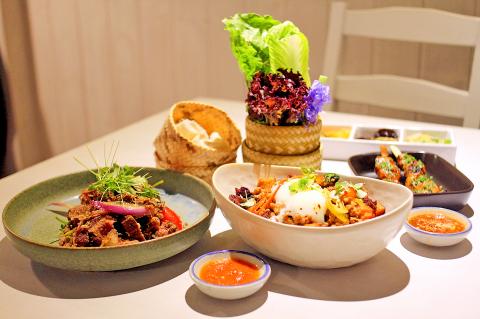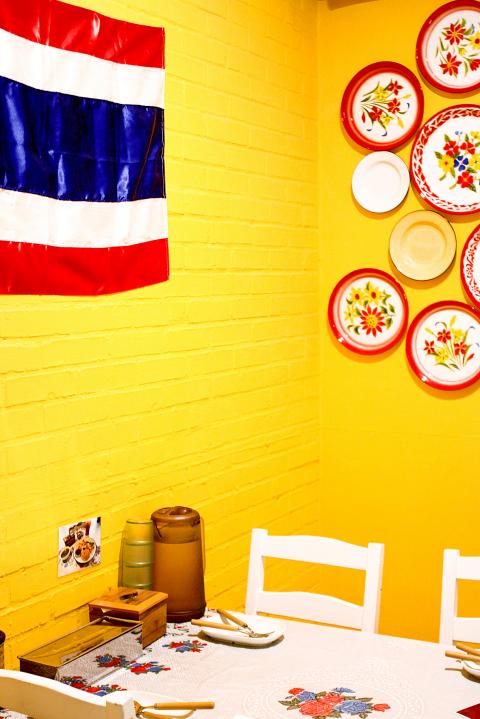Calvin Wang (汪義諠) has worked in some of Taipei’s best fine-dining kitchens, from French institution Joel Robuchon to the avant-garde Gen Creative. But for his first independent venture, the young chef, a self-described “third culture kid,” looked back to the comforts of his childhood in Bangkok.
Kao Jai Thai Bistro, his brainchild, opened this summer a couple of paces away from Breeze Center, adding to the many mid-market dining options in the area. Tables at the casual dining space span two floors, with an additional bar on the ground level and spacious private room in the basement.
The interior is lovingly decorated with artifacts hauled back from Thailand, from ornate PVC tablecloths to flowery enamelware, bamboo baskets and a portrait of the late Thai king. The decor may be homey and familiar, but the food is decidedly not.

Photo: Davina Tham, Taipei Times
You won’t find tom yum, green curry or pad Thai here. It’s obvious that Kao Jai isn’t interested in satisfying these tried-and-tested takeout cravings, which are all that some ever sample of Thai food. Instead, the menu distills chef Calvin’s experiments with new flavor and texture combinations that push at the boundaries of the Thai culinary realm.
Take the duck larb (NT$450) for example. Larb, a meat salad with fresh herbs, is commonly eaten in the Isan region of Thailand, bordering Laos, where it’s considered a national dish. Here, fresh mint, a kicker tamarind dressing and sweet-sour cherry tomatoes add layers of flavor that are discernibly Thai. But when the usual ground meat is swapped out for succulent chunks of duck, served slightly warm, that tips the dish over into newer territory.
If you eat pork offal, the nam tok (NT$420), or pork neck with pig’s liver and ears, will be irresistible. Perennial favorite som tam, or papaya salad, is also available, with betel nut leaves and salted egg (NT$250). But the emphasis is undoubtedly on grills and wok stir-fries.

Photo: Davina Tham, Taipei Times
Moo ping pork (NT$180) on skewers is well-executed, but pales in comparison to the superlative grilled chicken (NT$340). A whole thigh with charred skin and appetizingly pink, juicy meat is served with nam jim jaew, a spicy-sour dipping sauce.
Kao Jai puts a lot of thought into such accents. Every table gets a trio of pickles — guava, black fungus and radish, when I visited — as well as a bouquet of salad leaves and a fist-sized round of sticky rice to supplement the dishes with acidity and crunch, or mellow them out as needed.
Aside from the nam jim jaew, a Thai lime pesto and caramelized pineapple sauce can also go with other grills, like the beef tongue (NT$480) and chicken satay (NT$180). The fermented chili deepens heat and umami in just about anything you add it to.

Photo: Davina Tham, Taipei Times
A note about spice levels: the kitchen keeps the heat mild by default, to suit local palates, so tell the waitstaff if you don’t want them to hold back. I didn’t get the message across in time for my stir-fried ground pork with holy basil (NT$260), dialed up a notch by the addition of deeply caramelized sweet potatoes and a soft-boiled egg, and felt that it could do with more salt and heat.
I was also expecting punchier and aromatic notes in the Thai fried rice (NT$160), but the flavors here were muddled. The addition of a soft-boiled egg also seemed a bit overzealous, especially since it made the rice grains soggy.
Thai beer (NT$100) is the ideal accompaniment to this meal. The full menu is only available at night, but if you find yourself in the area on a weekday afternoon, Kao Jai also serves a business set of chicken rice (NT$220) with seasonal vegetables, pickles, egg and an iced Thai milk tea. It’s tender, healthful and filling.

Photo: Davina Tham, Taipei Times
Kao Jai hasn’t perfected its execution yet, but the newfangled dishes I’ve tried so far keep me hopeful that chef Calvin keeps thinking outside the box. Given the popularity of Southeast Asian cuisines here, it’s about time that one-of-a-kind Thai cooking found its way to Taipei.

April 14 to April 20 In March 1947, Sising Katadrepan urged the government to drop the “high mountain people” (高山族) designation for Indigenous Taiwanese and refer to them as “Taiwan people” (台灣族). He considered the term derogatory, arguing that it made them sound like animals. The Taiwan Provincial Government agreed to stop using the term, stating that Indigenous Taiwanese suffered all sorts of discrimination and oppression under the Japanese and were forced to live in the mountains as outsiders to society. Now, under the new regime, they would be seen as equals, thus they should be henceforth

Last week, the the National Immigration Agency (NIA) told the legislature that more than 10,000 naturalized Taiwanese citizens from the People’s Republic of China (PRC) risked having their citizenship revoked if they failed to provide proof that they had renounced their Chinese household registration within the next three months. Renunciation is required under the Act Governing Relations Between the People of the Taiwan Area and the Mainland Area (臺灣地區與大陸地區人民關係條例), as amended in 2004, though it was only a legal requirement after 2000. Prior to that, it had been only an administrative requirement since the Nationality Act (國籍法) was established in

Three big changes have transformed the landscape of Taiwan’s local patronage factions: Increasing Democratic Progressive Party (DPP) involvement, rising new factions and the Chinese Nationalist Party’s (KMT) significantly weakened control. GREEN FACTIONS It is said that “south of the Zhuoshui River (濁水溪), there is no blue-green divide,” meaning that from Yunlin County south there is no difference between KMT and DPP politicians. This is not always true, but there is more than a grain of truth to it. Traditionally, DPP factions are viewed as national entities, with their primary function to secure plum positions in the party and government. This is not unusual

The other day, a friend decided to playfully name our individual roles within the group: planner, emotional support, and so on. I was the fault-finder — or, as she put it, “the grumpy teenager” — who points out problems, but doesn’t suggest alternatives. She was only kidding around, but she struck at an insecurity I have: that I’m unacceptably, intolerably negative. My first instinct is to stress-test ideas for potential flaws. This critical tendency serves me well professionally, and feels true to who I am. If I don’t enjoy a film, for example, I don’t swallow my opinion. But I sometimes worry